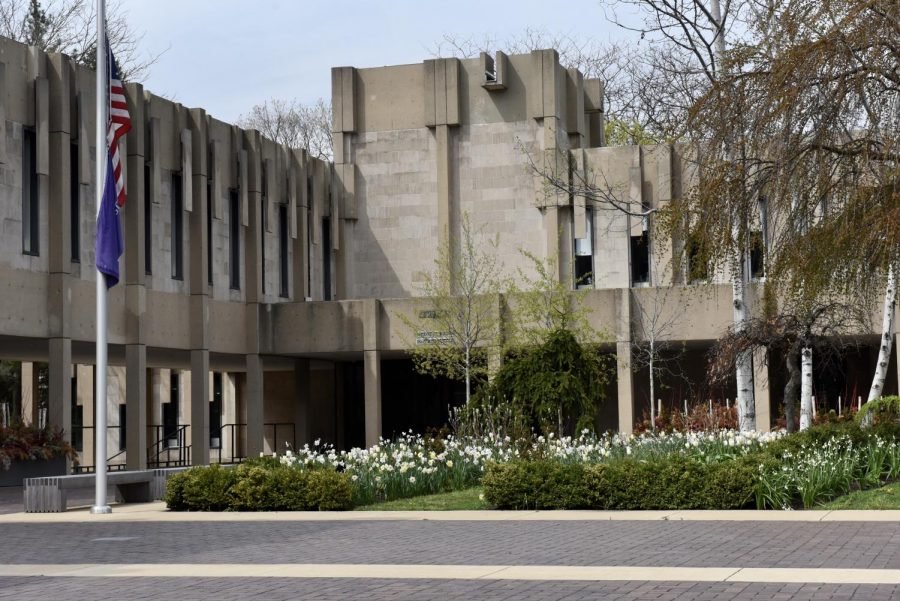Faculty voiced concerns about budget, transparency during January Faculty Senate meeting
Daily file photo by Catherine Buchaniec
Rebecca Crown Center, which includes the office of the Provost. The new hiring policy aims to increase diversity in University staffing.
January 14, 2021
Concerns about a lack of transparency and the University budget sparked debate during the January Faculty Senate meeting.
Faculty Senate President Therese McGuire delivered the Executive Committee’s response to the NU-AAUP report, which criticized several of the University’s academic decisions.
“We concur that there is room for improvement on the part of the administration, in terms of transparency consultation with the faculty in decision-making,” McGuire said. “However, we have a more tempered view of the situation than the authors of the report.”
McGuire cited both the difficulty of decision making during a pandemic and the existing routes of communication between the administration and the faculty as reasons for the committee’s more moderate response.
Multiple professors said they felt there was a lack of communication between the administration and the faculty at large or at least a lack of transparency around the avenues of communication between the Faculty Senate leadership and the administration.
McGuire said the Executive Committee is committed to greater transparency, better communication between the Faculty Senate and the rest of the faculty and more opportunities for faculty consultations on the University’s financial decisions.
Following the review of the report, Provost Kathleen Hagerty and Senior Vice President for Business and Finance Craig Johnson updated the Faculty Senate on the University budget and took questions.
Johnson’s language about the budget mirrored President Morton Schapiro’s email announcing the $83.4 million budget surplus for fiscal year 2020.
“We were glad to be positive, although that wasn’t by accident. That was certainly the result of sacrifice and a lot of hard work by our university community during a very challenging year,” Johnson said.
Johnson also echoed Schapiro’s warning that the surplus would not mean the end of careful spending, given that many pandemic-related costs will fall into fiscal year 2021.
He estimated that the University has spent between $30 and $40 million on testing so far and lost another $50 million due to the 10 percent reduction in tuition during Fall Quarter, low occupancy in campus housing and loss of athletic-related revenue.
While answering questions, Johnson confirmed that the University’s portfolio was up seven percent as of August due to the strong performance of the S&P 500. However, he stressed that the large portions of the endowment are non-liquid. Both Hagerty and Johnson emphasized that the surplus was a product of unexpectedly favorable outcomes, such as the rebound of hospital systems, which they hadn’t predicted when implementing austerity policies earlier in the pandemic.
According to Hagerty, the University has several spending priorities as it emerges from austerity, some of the highest being faculty and staff compensation as well as ending the hiring freeze. Hagerty said hiring priorities would go to both diversifying the faculty and supporting departments that require particular attention.
Budget and Planning Committee chair Martin Lariviere stated that some departments have been stretched especially thin from layoffs and staff who accepted voluntary separation packages. However, Lariviere said not to expect complete replacement of those positions as the University is “leery of letting the pendulum swing too far back.”
McGuire and Hagerty also said resources would be devoted to addressing the Organization of Women Faculty’s call to combat the pandemic’s disproportionate effect on caregivers. Initiatives mentioned included a caregiver grant and increased support through expanded work study programs.
Community safety and infrastructure spending on facilities and information technology will also be a priority, Hagerty said. She deferred any concrete spending allocation decisions until next year, when the University will have a better idea of the impact of the pandemic’s effects on spending.
“The super tight spot we’ve been in, we’re going to come out of that and we’re going to start doing things together,” she said. “That’s my plan for next year.”
Correction: A previous version of this article stated that departments had been stretched thin by faculty layoffs. It has been updated to reflect that departments have been stretched thin by staff, not faculty, layoffs. The Daily regrets the error.
Email: [email protected]
Twitter: @meganmuncie
Related Stories:
— Administrator, Prof. Yancy discuss Community Safety Advisory Board at Faculty Senate
— Office of Equity talks changes to Title IX policy at October Faculty Senate meeting
— Provost Hagerty talks Winter Quarter plans at October Faculty Senate meeting


